

Antock.co.,Ltd, the company I work for, has been selected as an outstanding collaboration case in the financial sector for the 'D.CAMP Startup OI (Open Innovation)' program hosted by D.CAMP and the Korea FinTech Support Center, and is scheduled to present on the 31st. While preparing for the event, I reviewed each of the collaboration projects my company has carried out with financial and public institutions over the past decade. Some cases were satisfying, while others left some regret. I have compiled my own criteria and key factors for successful Open Innovation based on this review, which I would like to share with readers.
First, Open Innovation is a concept first introduced in 2003 by Professor Henry Chesbrough of UC Berkeley. The core idea is that linking resources within an organization with external technology and ideas can further accelerate corporate innovation. Especially with the advent of the Artificial Intelligence (AI) and Digital Transformation (DX) era, the agile technology of startups has become an essential element for large corporations that find it difficult to keep pace with R&D (Research and Development) alone. In fact, in Korea, various Open Innovation programs are emerging, highlighting it as a major channel for large corporations and technology companies to achieve mutual growth and synergy. Collaboration takes various forms, including PoC (Proof of Concept), joint R&D, and business partnerships.
So, how is successful Open Innovation achieved? While some collaborations result in strategic alliances or joint ventures, the majority end as a one-time event. What I have realized through numerous trials and errors is that the probability of success in Open Innovation increases when a structure is established where both organizations can form a long-term 'one team' to pursue mutual benefits. While this might sound somewhat textbook and abstract, it is a prerequisite for successful collaboration.
First, a long-term perspective is needed to create meaningful outcomes through Open Innovation. This is because the work involves mutually complementing the inherently different capabilities of a large corporation and a startup. Although most domestic Open Innovation programs are designed to produce results within a certain period, a structure is needed to ensure collaboration continues even after the event concludes. When I participated in a major bank's program, it initially amounted only to a fragmentary technology demonstration. However, we were later able to prepare for actual service commercialization by undertaking eight additional projects over the following two years.
Furthermore, the large corporation and the startup must genuinely establish a 'One-Team' system. In a transactional relationship where the large corporation simply provides funding and the startup produces and reports the results of the technology application, it is difficult to expect internalized innovation. Shared knowledge and know-how can only be exchanged through a common goal and a densely collaborative discussion process. In my experience, physically collaborating in the same space with the large corporation's practitioners during the Open Innovation period had a higher probability of project success than when we did not.
Finally, the interests of both the demand company and the startup must be aligned for a win-win structure. Open Innovation is neither a one-sided means for a large corporation to secure technology nor merely a stage for a startup to show off its capabilities. The startup must aim to apply its technology to meet actual client needs beyond simple experimentation, securing clear references, and the large corporation must provide reasonable support for this. Through this, the large company can seek substantive changes in its business processes, not just nominal collaboration, and the startup can gain meaningful references for future expansion.
The intent and principles of Open Innovation are simple, but since the work involves promoting business innovation in a massive organization using the technology of a nascent startup, it is easier said than done. Therefore, while numerous Open Innovation programs exist, those that lead to actual commercialization are limited. I hope that by setting common goals through transparent communication, understanding and being considerate of each other within an organic collaborative relationship, and approaching the process with a long-term view, the number of successful Open Innovation cases will increase.